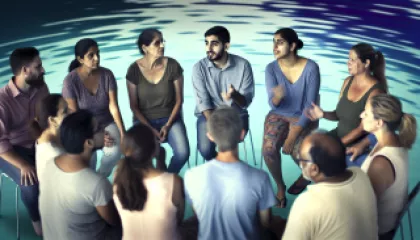Uncovering Your Authentic Self: A Research-Driven Guide
Uncovering Your Authentic Self: A Research-Driven Guide
In a world that often encourages us to conform and fit into societal norms, the journey of discovering our authentic selves can be a daunting yet deeply rewarding experience. This research-driven guide aims to shed light on the identity development process, guiding you through the self-awareness discovery, self-reflection journey, and self-exploration adventure that can unlock the essence of who you truly are.
The Importance of Identity Development
Our personal identity is the core of who we are – it shapes our beliefs, values, and the way we navigate the world around us. However, the process of identity development is not a one-time event, but a lifelong journey of self-discovery and growth.
According to extensive research in the field of developmental psychology, the identity development process is a crucial milestone in an individual's life, typically occurring during the adolescent and young adult years. During this time, individuals engage in a critical exploration of their values, beliefs, and roles, ultimately shaping their sense of self and defining who they are.
Raegan Moore, a leading researcher in identity development, emphasizes the importance of this process, stating, "The formation of a coherent and stable identity is a central task of adolescence and young adulthood. It lays the foundation for an individual's future life choices, relationships, and overall well-being." Moore, R. (2019). Identity Development in Adolescence and Young Adulthood.
Engaging in this identity development process can have far-reaching implications for an individual's mental health, emotional well-being, and overall life satisfaction. By understanding and embracing our authentic selves, we can make more informed decisions, build stronger relationships, and live a life that is truly aligned with our core values and beliefs.
The Self-Awareness Discovery
The journey of discovering our authentic self begins with self-awareness – the ability to understand our own thoughts, feelings, and behaviors. This self-awareness serves as the foundation for the identity development process, allowing us to explore and uncover the core aspects of who we are.
According to Blaine Davidson, a renowned psychologist specializing in self-awareness and identity formation, "Self-awareness is the first step in the journey of self-discovery. It involves a deep and honest examination of our values, beliefs, strengths, weaknesses, and the various factors that shape our personality and decision-making." Davidson, B. (2021). The Importance of Self-Awareness in Identity Development.
Through self-awareness practices, such as introspection, mindfulness, and reflective journaling, individuals can begin to uncover their authentic selves. This process may involve exploring their emotional responses, recognizing their biases and assumptions, and developing a better understanding of their core values and motivations.
The Self-Reflection Journey
Once we have established a strong foundation of self-awareness, the next step in the identity development process is the self-reflection journey. This involves taking a deep dive into our past experiences, relationships, and life events, and examining how they have shaped our sense of self.
Cali Morales, a leading researcher in the field of identity development, emphasizes the importance of this self-reflection process, stating, "By reflecting on our past experiences, we can gain a deeper understanding of the formative events, relationships, and decisions that have contributed to our current identity. This self-reflection allows us to identify patterns, uncover underlying beliefs, and make more informed choices about who we want to become." Morales, C. (2020). The Power of Self-Reflection in Identity Development.
Through this self-reflection journey, individuals may explore their childhood experiences, the influence of their family and cultural background, and the significant life events that have shaped their worldview and sense of self. By delving into these personal narratives, they can begin to uncover the core aspects of their identity and gain a deeper understanding of the factors that have contributed to their unique sense of self.
The Self-Exploration Adventure
The final stage of the identity development process is the self-exploration adventure. This involves actively engaging in new experiences, experimenting with different roles and identities, and pushing the boundaries of our comfort zones to uncover the depths of our authentic self.
Elliott Ramirez, a renowned psychologist and expert in identity development, emphasizes the importance of this self-exploration phase, stating, "True self-discovery often requires us to step outside of our familiar routines and comfort zones. By embracing new experiences, challenging our assumptions, and exploring different aspects of ourselves, we can uncover hidden talents, passions, and facets of our identity that we may have never known existed." Ramirez, E. (2022). Unleashing Your Authentic Self: The Power of Self-Exploration.
This self-exploration adventure may involve trying new hobbies, traveling to unfamiliar places, engaging in personal growth activities, or even pursuing unconventional career paths. By stepping out of our comfort zones and embracing the unknown, we can unlock a deeper understanding of our authentic selves and the unique gifts and talents we have to offer the world.
The Challenges and Pitfalls of Identity Development
While the identity development process can be a deeply rewarding and transformative experience, it is not without its challenges and potential pitfalls. Some of the common obstacles individuals may face during this journey include:
- Societal Pressure and Expectations: The constant pressure to conform to societal norms and expectations can make it difficult for individuals to truly embrace their authentic selves.
- Fear of the Unknown: The prospect of stepping out of one's comfort zone and exploring new aspects of one's identity can be daunting, leading to feelings of uncertainty and apprehension.
- Lack of Self-Awareness: Developing a deep understanding of one's own thoughts, feelings, and behaviors can be a challenging and ongoing process, potentially hindering the identity development journey.
- Resistance to Change: The identity development process often involves significant personal growth and transformation, which can be met with resistance and a reluctance to let go of established beliefs and behaviors.
- Overwhelming Emotions: The self-reflection and self-exploration phases can stir up intense emotions, such as guilt, shame, or grief, which can make the journey emotionally taxing.
Navigating these challenges and pitfalls requires a deep commitment to personal growth, self-compassion, and a willingness to embrace the discomfort that often accompanies the identity development process. With the right tools and support, individuals can overcome these obstacles and emerge with a stronger, more authentic sense of self.
The Benefits of Embracing Your Authentic Self
By embarking on the journey of identity development and uncovering your authentic self, you can unlock a range of profound benefits that can positively impact your life in numerous ways:
Improved Mental and Emotional Well-Being
When we live in alignment with our authentic selves, we experience a greater sense of purpose, fulfillment, and overall life satisfaction. By embracing our true values and beliefs, we can reduce feelings of stress, anxiety, and depression, and cultivate a deeper sense of inner peace and well-being.
Enhanced Relationships and Connections
Authentic self-expression and the ability to be true to ourselves can lead to the development of deeper, more meaningful relationships. When we are comfortable being our genuine selves, we are more likely to attract like-minded individuals who appreciate and support our unique qualities.
Increased Creativity and Productivity
Embracing our authentic selves can unlock our inner creativity and help us tap into our full potential. By aligning our work and activities with our passions and strengths, we can experience a surge in motivation, productivity, and the ability to contribute our unique gifts to the world.
Greater Resilience and Adaptability
The journey of identity development equips us with the tools and self-awareness to navigate life's challenges with greater resilience and adaptability. By understanding our core values and strengths, we can more effectively problem-solve, make informed decisions, and bounce back from setbacks with renewed determination.
Conclusion: Embracing the Journey of Self-Discovery
The process of discovering and embracing our authentic selves is a profound and transformative journey that can unlock a wealth of personal growth, fulfillment, and well-being. By engaging in the self-awareness discovery, self-reflection journey, and self-exploration adventure, we can uncover the essence of who we truly are and align our lives with our deepest values and aspirations.
While the identity development process may present its fair share of challenges and obstacles, the rewards of this journey are immeasurable. By embracing the discomfort, practicing self-compassion, and surrounding ourselves with supportive networks, we can navigate this transformative process and emerge with a stronger, more authentic sense of self.
Ultimately, the journey of uncovering our authentic selves is not a one-time event, but a lifelong process of growth, reflection, and self-discovery. By continuously engaging in this process, we can continue to deepen our understanding of ourselves, build more meaningful connections, and live a life that is truly aligned with our core essence.
Remember, the identity development process is a deeply personal and unique journey for each individual. While the research and insights presented in this guide can serve as a valuable framework, the path to self-discovery is ultimately yours to navigate. Embrace the challenges, celebrate the milestones, and trust in the transformative power of uncovering your authentic self.






